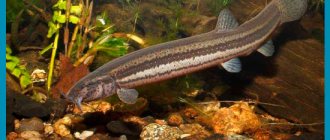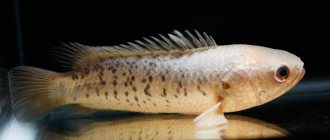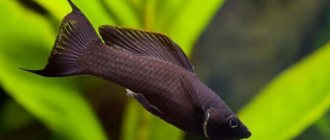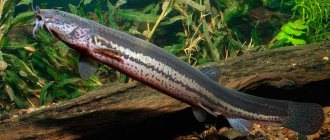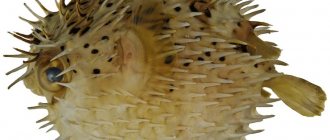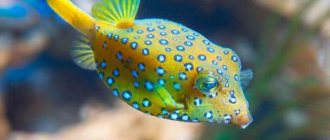Post Views: 2,649
5
(2)
Aquarium fish simply amaze with their diversity. Representatives of different species can differ from each other in a wide variety of parameters: color, shape, size. There are both miniature creatures, less than 3 cm long, and giants, which, when created under acceptable conditions, grow up to 50 cm. The choice of certain options will directly depend on the preferences of the future owner. In this article I will describe the Top 10 large aquarium fish.
Akara turquoise
A miniature artificial pond is not suitable for keeping turquoise acara. The length of adult individuals is about 30 cm. Therefore, if you need to place a couple of fish, you should choose containers with a volume of more than 300 liters. It is very sensitive to water quality.
Representatives of this family come from South America. Average life expectancy is 8 years. They have an incredibly beautiful silver-gray color, bluish-green scales, located throughout the body. The unusual coloring harmoniously combines with the wide yellow edging of the fins. A distinctive feature of males is the presence of a pronounced fatty lump.
Individuals are distinguished by interesting behavior. Turquoise Akara has become famous for its increased aggressiveness. That is why its second name is “green terror”. For this reason, you should carefully select your roommates. Ideal options are sized catfish or other cichlids.
Females behave completely differently after mating; they simply amaze with their well-expressed parental instinct. They incubate the eggs in their mouths until the fry hatch. They care for the offspring until they learn to feed themselves.
Akara turquoise
Arowana
Arowana can rightfully be called the largest aquarium fish. The body length of a giant can be from 60 to 100 cm. Therefore, the volume of an aquarium for such a pet should be about 1000 liters. The container must be equipped with a lid, since living creatures can jump 3 meters out of the water. You should also equip the habitat with a powerful filter.
Arowana has an elongated body, slightly compressed on the sides, covered with beautiful mirror scales. Adults are especially beautiful - they shimmer like ingots of gold. A fairly capacious mouth, capable of swallowing large prey. On the lower jaw there is a pair of whiskers - locators that detect the slightest fluctuations in water. This feature helps to hunt successfully. Animals feed primarily on animal feed. Arowanas live up to 8 years.
Peaceful, calm fish are not suitable as neighbors in a common aquarium. Arowana will simply plague them with constant terror. The proximity of small individuals is also strictly prohibited; they will quickly become prey for predators. Even relatives can become victims of aggressors.
Arowana
Astronotus
The natural habitat of astronotus is South America. In the wild, such animals grow up to 45 cm, at home - 25-30 cm. These are quite hardy cichlids that adapt well to a variety of conditions. Other names are peacocks, ocellatus, oscars, corduroy cichlids.
The popularity of this species is due to its unusual intelligence. According to the owners, astronotuses are able to recognize their owners and sometimes allow themselves to be stroked. These are beautiful colorful fish with a streamlined body, a pointed head, and large eyes. The dorsal and anal fins, as well as the tail, are interconnected, forming a kind of fan.
These are predators that are best kept in pairs. Juveniles can live in small groups. The main condition is that each individual must have 100 liters of water. The presence of a special transparent lid will prevent fish from jumping out and water splashing. Astronotus are characterized by panic attacks, during which they rush chaotically around the aquarium.
Such cichlids are loyal to the neighborhood with comparable representatives of other classes. Keeping small species is strictly prohibited. Everything that the astronotus can grab in its mouth quickly becomes food for it.
Astronotuses
Pangasius
Pangasius or “shark catfish” is a large, voracious, freshwater fish that looks very similar to smaller copies of the predators of the same name. It is the terrifying appearance and graceful movements that attract the attention of future owners. Externally, it is an aquarium fish with an elongated body, flattened on both sides, and a large head.
Since representatives of this species can reach 50 cm in length, are very active and love space, the volume of the aquarium should be at least 400 liters. Mature females are slightly larger than males and have lighter colors. It is almost impossible to distinguish young animals by gender.
Reproduction in an aquarium is very rare due to the size of the fish, as well as the high requirements for spawning grounds.
Pangasius is loyal to the composition of water or feed. Despite their fighting appearance, pangasius have poor eyesight and are very timid, beginning to panic at the slightest sudden movement. They feel better living in flocks of 5 or more individuals.
Fish have very delicate skin, so there should not be any sharp objects that could cause injury. Neighborhood is only possible with individuals that cannot fit into the mouth of a predator.
Pengasius
Lakedra: beneficial properties
Undoubtedly, lakedra is very useful. And its benefits manifest themselves in a variety of directions.
1. With regular use of the product, you can improve the condition of your internal organs, as well as your appearance. This applies to people of any age and gender.
2. Scientists have found that eating the meat of this fish protects against the appearance of tumors and is the secret of long youth.
3. It contains many antioxidants. They are extremely important for protecting internal organs and maintaining optimal appearance. Antioxidants are elements that are also beneficial for the skin.
4. Regular consumption of yellowtail improves the body's immune defense. According to observations, people who often included the product in their diet were more protected against colds and viruses. The period of illness, if the disease did appear, was shorter. Thus, during a virus outbreak, this product must be on the table.
5. Another important property is strengthening the heart and blood vessels. Even those who suffer from hypertension are advised to eat it, as the product does a good job of lowering high blood pressure.
6. Yellowtail meat contains fatty acids. In addition, the product can also help with other heart problems.
7. You should definitely eat fish to support optimal functioning of the gastrointestinal tract. This way you can improve the process of digesting food.
8. Consumption of lakedra is also a prevention of atherosclerosis. Even though such food contains cholesterol, the product brings great benefits. In fact, it contains only “good” cholesterol, and it is needed for the health of the vascular system.
9. They say that fish meat has a positive effect on brain activity. The product improves memory and attention. This means that it will be useful to people whose work involves mental activity.
10. The beneficial components of fish will be important in the fight against depression and neuroses.
Lakedra meat
Piranha
It is difficult to find a person who has not heard about the bloodthirstiness of piranhas. But, there are people who not only are not afraid of predators, but prefer to keep them at home.
In their natural environment, piranhas live in the rivers of South America. With sharp plate-like teeth, wild fish are able to bite through a wooden stick as thick as a human finger. But pets are less aggressive and have retained an exceptionally menacing appearance. You can safely put your hands down in an aquarium with representatives of characins.
The body of critters is quite high, strongly compressed from the sides, covered with beautiful steel scales with a silver or gold tint. The jaws are powerful. Representatives of the aquatic element are schooling, so they prefer to live in groups of 5-8 fish of the same age and size. The length of mature individuals is 35 cm. Accordingly, the container for such fish should have a volume of at least 300 liters.
Piranhas are not able to get along with representatives of other species. When adding other fish, conflicts cannot be avoided. But the fish is afraid of sharp sounds. From fright he even loses consciousness for a short time. Therefore, it is advisable to equip the aquarium with numerous shelters made of pebbles, shells, and algae so that the pets feel as calm and comfortable as possible.
Piranha
Lakedra: harm and contraindications
Eating yellowtail is generally not harmful. However, there are people who have contraindications; they should not add lakedra to their diet. The main contraindication is an allergic reaction.
Seafood itself is quite allergenic. Accordingly, it is impossible to say that yellowtail in this regard will be safe for allergy sufferers.
If you eat it in large quantities, it will provoke obesity. However, any product, if eaten without moderation, can lead to weight gain.
Poorly processed meat will cause harm; parasites may remain in it, which will lead to adverse consequences. Accordingly, you need to cook fish carefully and slowly.
If it was stored incorrectly, it is better to dispose of it. It will not bring any benefit and will most likely disappoint with its taste.
Pterygoplicht brocade
Pterygoplicht brocade or as it is also called catfish-prilipala is deservedly considered one of the largest representatives of its family. They grow up to 50 cm. The aquarium for their maintenance must be at least 250 liters.
Catfish grow very slowly, reaching their maximum length only after reaching the age of five. The average life expectancy is 10-15 years. Thanks to its beautiful spotted coloring, this beauty will undoubtedly become a real decoration for any aquarium. Moreover, the background color of the body can be of a wide variety of shades: golden brown, black, olive, gray, green, yellow or orange. Males are larger, brighter, and have spines on their pectoral fins.
Despite its impressive size, it is a peaceful, herbivorous creature that coexists peacefully with other fish. The brocade pterygoplichthus spends most of its time at the bottom eating algae. A few individuals will be enough to keep the aquarium clean.
Catfish are especially active at night. Therefore, it is imperative to provide shelter so that the fish can rest there during the day. Ideal options are driftwood made of natural wood.
Pterygoplicht brocade
How to choose when purchasing
In order for the fish to really bring benefits and not disappoint with its taste, you need to choose it correctly. She definitely needs to look into her eyes. They should be clear and light.
Blood in the eyes, looking down or backward indicates improper transportation or non-compliance with the storage conditions of the product. Now you should pay attention to the shade of the carcass. It must be natural.
The fact that the fish is stale is indicated by defects, a loose, weathered body, a dry tail and fins. If there is a lot of ice on the carcass, then most likely it has been frozen several times.
Savvy shoppers are also reminded to inspect the gills. These parts of fresh fish are bright and free of spots. And the whole carcass should smell like the sea, and not algae or anything else. You need to buy fish only from trusted retail outlets, and not from the market.
How to cook deliciously
Parrot fish
This is one of the most popular aquarium fish, obtained by crossing several varieties of cichlases by Asian breeders. Such pets attract attention with their bright colors and large triangular mouth, as if spreading into a constant smile. Due to this unusual anatomical structure, the fish require special food.
The body is barrel-shaped, with small fins and a deformed swim bladder. Parrots move slowly and clumsily. The shade of the scales is uniform, most often yellow, orange or red. The fins are usually colored to match the body color.
Such fish grow up to 30 cm. It is recommended to choose an aquarium with a volume of at least 250 liters. It is imperative to arrange numerous shelters in which timid parrots will hide when they sense danger.
Parrot fish are quite calm, cheerful, friendly, and make excellent contact with their owners. Such peaceful creatures will not be able to get along with large predatory fish.
Since parrotfish are sterile, it will not be possible to produce offspring. They can live up to 10 years. And, thanks to its unpretentiousness, even a novice aquarist can keep fish.
Fish - parrot
Flower Horn
Flower Horn is another creation of Asian breeders. But, unlike parrot fish, such pets are able to reproduce at home. This variety of cichlids simply amazes with its bright color and unusual shape. The main advantage of these is the fatty growth on the head. And the larger the rainbow horn, the more expensive the fish.
On sale you can find Flower Horns in a wide variety of colors. The scales can be pink, red or silver-gray. Irregular shiny spots are located all over the body. Males are more brightly colored than females.
The length of the giant is about 45 cm. When choosing a suitable aquarium, you should take into account that there must be at least 150 liters of water per individual. In case of group keeping, this criterion should be increased to 800 liters, since hybrids are characterized by increased territoriality and aggressiveness not only towards representatives of other species, but also relatives.
It is very easy to care for such fish. They are absolutely loyal to food and water quality. Flower Horn can live up to 10 years.
Flower
Lakedra - what kind of fish, where is it found, description, what does it eat
Lakedra is a marine heat-loving fish. It can be found in the Primorsky Territory, Karya, Japan. The Japanese use it to prepare sashimi and sushi. Its main difference is its gray-blue scales.
The yellowtail has a brown stripe on its body and its sides are slightly flattened. The fish usually weighs about 1 kilogram, but cases of catching individuals reaching 10 kilograms have been recorded.
Lakedra can move quickly in the water column. This is explained by the torpedo-shaped body shape. Yellowtail feeds on mackerel, anchovies and sardines. Yellowtail winters closer to southern waters.
The lifespan of this fish is about 12 years. Under artificial conditions, it is fed with minced meat, which is made from low-value breeds of other fish. Sometimes mixed feed is used.
However, even under artificial conditions, fish turns out to be no less valuable in terms of the composition of its meat. By the way, meat is considered a real delicacy. In Russia, yellowtail is caught off the coast of Primorsky Krai and Sakhalin.
Frontosa
Many aquarium masters dream of getting their hands on the majestic striped frontosa. Due to her majesty and aristocratic beauty, she is often called the Queen of Tanganyika.
Adults grow up to 30 cm and are kept in spacious 300-liter aquariums. It is recommended to keep cichlids in harems, where there is one male and several females. Due to their predatory lifestyle, proximity to small species is strictly prohibited. Any living creature that can fit in the mouth becomes food. The natural habitat of frontosa is the African waters of Tanganyika.
These are calm, imposing fish that are pleasant to watch. They are highly intelligent, quickly get used to their owners, and allow themselves to be hand-fed and petted.
By the intensity of the color of the stripes you can judge the well-being of the fish. If they are pale, the inhabitants of the aquarium are clearly experiencing some kind of discomfort. Pets prefer well-purified water, sufficiently saturated with oxygen. Therefore, it is definitely recommended to equip the aquarium with a powerful compressor and filter.
Frontosa
Chemical composition and calorie content
It is unlikely that this fish can be called dietary. Approximately 100 grams of meat accounts for 250 kilocalories . And the main problem can be considered that the main calorie content comes from the fats contained in yellowtail meat.
However, there is a lot of protein in the product. According to calculations, its concentration is 35% of the weight of the fish.
Lakedra contains a large amount of vitamins and microelements. Its meat is especially valued for the presence of vitamins A, C, PP. And the most valuable minerals in the product are:
- copper,
- magnesium,
- phosphorus,
- iron,
- zinc,
- selenium.

